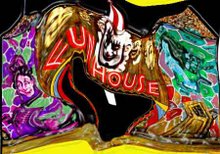Update - The Frog in Nefertari's Tomb
You may remember my confusion about the frog in one of the panels in Nefertari's tomb:
His paper explains that to the left of the Queen is spell 94 from The Book of the Dead concerned with providing the dead soul with writing equipment. Okay, but...??!? Prior scholars connect the Frog to rebirth (probably because of those already mentioned fertility connections) or say that it is actually a water pot in the shape of a frog.
Kaper notes that we have no in text references to the frog, but the spell, which hales from a particular 19th Dynasty version of the Book of the Dead reads as follows:
"Spell of requesting a water pot and a palette from Thoth in the necropolis by the Osiris the king's great wife, the mistress of the Two Lands, Nefertari beloved of Mut, justified: O great one who is recognised by his father, keeper of the Book of Thoth;^" see, I have come transfigured, possessed of a soul (ba), mighty and equipped with the writings of Thoth. Hasten to me Aker, who is in the hidden place;" bring me a water pot, bring me a palette and that writing case^^ of Thoth, and the secrets that are in them, (i.e.) the gods. Look at me; I am a scribe. Bring me the effluence of Osiris, that (I) may write (therewith) what the great god says perfectly every day, by the perfection which you have assigned to me, Harakhty. I shall do what is right (jnaat) and I shall attain what is right (maat)".
Kaper suggests that by being able to use the writing implements of Thoth, the transcriber of judgment of earthly behavior of the deceased, Nefertari would be able to write her own judgment. Since the Book of the Dead offers no real solution to why there is a frog on the water vessel, he looks for other instances of frogs and what frogs might mean. It was already suggested that because the flooding of the Nile would bring quantities of mud onto land, it was likely that Egyptians might associate the abundance of frogs hatching from tadpoles in the mud with the fertility and abundance of the Nile. Kaper reminds us of the plague of frogs visited on Pharaoh in the Bible. He also looks to the few other instances of frogs he was able to identify in Egyptian art of the time.
One of these was an item we had actually seen in the Egyptian Museum in Cairo. In the exhibit of the artifacts from the tomb of Tuya and Yuya, there were some "false" vases with various figures on the lids.
The museum identifies them as false containers for oils because they are limestone vases with only a small space dug out of the inside. They are thus representative of vases that would serve the needs of the dead. Four vases were attached to a wooden board, each has an animal perched on the lid, two have calf's heads, one has a reclining ibex and one is ... a frog. Kaper identifies these as false water vessels, which could thus connect the frog with the water pot depicted as a part of the writing "kit" presented to Nefertari by Thoth on the wall panel. I think it is a good theory, but if anyone has a better one, let me know.
If you want to read the entire article, here is the information about it:
Kaper, Olaf E., "Queen Nefertari and the Frog, on an amphibious element in the vignette BD 94,"Bulletin of the Australian Centre for Egyptology, 13, (2002) 109-126






No comments:
Post a Comment